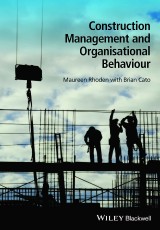Details
Construction Management and Organisational Behaviour
1. Aufl.
|
39,99 € |
|
| Verlag: | Wiley-Blackwell |
| Format: | EPUB |
| Veröffentl.: | 02.05.2017 |
| ISBN/EAN: | 9781118674574 |
| Sprache: | englisch |
| Anzahl Seiten: | 240 |
DRM-geschütztes eBook, Sie benötigen z.B. Adobe Digital Editions und eine Adobe ID zum Lesen.
Beschreibungen
This book offers a comprehensive and up-to-date account of management ideas and practices, focusing on the human relations side of construction management. Easily accessible and suitable for use within the classroom or in distance learning situations, it discusses a range of themes and trends covering evidence based management practices in the construction industry. A variety of learning elements will be included, such as case studies, projects, and review questions, fully supported by interactive web based material including multiple choice questions, exercises, annotated links to other relevant web sites and an online glossary to explain key terms. Each chapter will also contain annotated further reading, chapter summaries and outline summaries of relevant legislation within the construction industry.
<p>About the Authors ix</p> <p><b>1 Introduction 1</b></p> <p>Structure of the book 1</p> <p><b>2 History of Management 3</b></p> <p>Introduction 3</p> <p>Scientific management 3</p> <p>Classical theory 4</p> <p>Human relations theory 6</p> <p>The Hawthorne studies and human relations theory 8</p> <p>Theory X and Theory Y 9</p> <p>Decision theory 10</p> <p>Work activity theory 10</p> <p>Competencies theory 10</p> <p>Process theory 10</p> <p>Is management a science or an art? 10</p> <p>Conclusion 12</p> <p>Chapter summary 13</p> <p>Useful website 13</p> <p>Further reading 13</p> <p>References 13</p> <p><b>3 The Nature of Management 15</b></p> <p>Introduction 15</p> <p>The role of a manager 15</p> <p>Contemporary management functions 18</p> <p>The organisation’s expectations 21</p> <p>The person 21</p> <p>Balancing different management roles 22</p> <p>Conclusion 22</p> <p>Chapter summary 22</p> <p>Useful website 22</p> <p>Further reading 22</p> <p>References 23</p> <p><b>4 Leadership 25</b></p> <p>Introduction 25</p> <p>Behavioural theories 27</p> <p>Situational leadership 28</p> <p>Contingency theories 28</p> <p>Individual leadership skills 30</p> <p>Leadership styles 31</p> <p>Changing leadership styles 36</p> <p>Chapter summary 43</p> <p>Useful website 43</p> <p>Further reading 43</p> <p>References 44</p> <p><b>5 Communications and Motivation 45</b></p> <p>Introduction 45</p> <p>Motivation 49</p> <p>What is motivation? 50</p> <p>The process of motivation 50</p> <p>Expectations from work 51</p> <p>Barriers to motivational behaviour 51</p> <p>Theories of motivation 52</p> <p>Chapter summary 59</p> <p>Useful websites 60</p> <p>Further reading 60</p> <p>References 60</p> <p><b>6 Conflict and Negotiation 63</b></p> <p>Introduction 63</p> <p>Negotiation game plan 66</p> <p>Receiving notification of a potential conflict 67</p> <p>Win–win conflict negotiation 68</p> <p>Negotiating a compromise position 69</p> <p>Withdrawing from the conflict 70</p> <p>Smoothing the conflict through negotiation 71</p> <p>Chapter summary 73</p> <p>Useful website 73</p> <p>Further reading 73</p> <p>References 73</p> <p><b>7 Creative Problem Solving 75</b></p> <p>Introduction 75</p> <p>Bounded and unbounded problems 75</p> <p>Solving problems 78</p> <p>Messy, soft or wicked problems 79</p> <p>Creative problem solving – individuals 82</p> <p>Creative problem solving – teams 86</p> <p>Brainstorming techniques for teams 87</p> <p>Case studies 91</p> <p>Selecting appropriate problem solving techniques 92</p> <p>Chapter summary 92</p> <p>Useful websites 92</p> <p>Further reading 93</p> <p>References 93</p> <p><b>8 Managing Organisational Change 95</b></p> <p>Introduction 95</p> <p>Brief history of organisational change 95</p> <p>Managing change 98</p> <p>Triggers for organisational change 99</p> <p>Determinist and voluntarist models 103</p> <p>Perceptions of organisational change 104</p> <p>Communicating organisational change 105</p> <p>Employee interpretations of organisational change 106</p> <p>Individual resistance to change 107</p> <p>Transitioning nature of sites and project teams 108</p> <p>Group interpretations of organisational change 109</p> <p>Group resistance to change 109</p> <p>Planned organisational change 110</p> <p>Organisational development and change 113</p> <p>The situational approach to change management 114</p> <p>John Kotter’s model 115</p> <p>Political influences and change management 117</p> <p>Chapter summary 119</p> <p>Useful websites 119</p> <p>Further reading 119</p> <p>References 120</p> <p><b>9 Entrepreneurship and Innovation 125</b></p> <p>Introduction 125</p> <p>Characteristics of successful entrepreneurs 125</p> <p>Work style 130</p> <p>Leadership style 132</p> <p>The entrepreneur as a leader 134</p> <p>Innovation 135</p> <p>Organisational culture 137</p> <p>Disruptive innovations 139</p> <p>Change for the sake of change? 140</p> <p>Small enterprises 141</p> <p>Chapter summary 143</p> <p>Useful websites 143</p> <p>Further reading 143</p> <p>References 143</p> <p><b>10 Organisational Culture 147</b></p> <p>Introduction 147</p> <p>Culture has vs culture is 148</p> <p>Integration vs differentiation/fragmentation 149</p> <p>Culture managed vs culture tolerated 149</p> <p>Symbolic leadership vs management control 149</p> <p>The iceberg model 150</p> <p>Theories of organisational culture 153</p> <p>Globalisation and cultures 161</p> <p>Organisational socialisation 161</p> <p>National cultures 163</p> <p>Chapter summary 166</p> <p>Useful website 167</p> <p>Further reading 167</p> <p>References 167</p> <p><b>11 Organisational Strategy 169</b></p> <p>Introduction 169</p> <p>Stakeholders 171</p> <p>Competitive advantage 174</p> <p>Porter’s five forces 174</p> <p>Organisational capability 175</p> <p>The strategic loop 177</p> <p>Strategic approaches in small firms 184</p> <p>Chapter summary 184</p> <p>Useful websites 185</p> <p>Further reading 185</p> <p>References 185</p> <p><b>12 Organisations and Structures 187</b></p> <p>Introduction 187</p> <p>Theoretical models of organisational structure 190</p> <p>Organisational design 196</p> <p>The shamrock organisation 202</p> <p>Situational factors 204</p> <p>Chapter summary 205</p> <p>Useful websites 205</p> <p>Further reading 205</p> <p>References 205</p> <p>Index 209</p>
<b>About the Author</b> <p><b>Maureen Rhoden</b> is Senior Lecturer in the Department of Built Environment at the University of Greenwich, London. She specialises in the study and teaching of soft skills in construction management in addition to supervising dissertations of undergraduate and postgraduate students researching in soft skills and construction management related Issues.</p> <p><b>Brian Cato</b> is Senior Lecturer in the Department of Built Environment at the University of Greenwich, London. He is a Chartered Quantity Surveyor and Project Manager with 30 years? experience in the construction industry, 25 of them in private practice and latterly 5 years in education.</p>
<b>Construction Management and Organisational Behaviour Maureen Rhoden with Brian Cato</b> <p><i>Construction Management and Organisational Behaviour</i> provides a comprehensive account of management ideas and practices, focusing on human relations within construction management. Easily accessible and suitable for use in face to face or in distance learning situations, it discusses a range of themes and trends covering evidence based management practices in the construction industry. A variety of learning elements are included, such as chapter summaries, case studies, reflective questions, useful websites and annotated further reading lists. Final year and post graduate students of construction and civil engineering, as well as managers at all levels within the construction industry, will find this an ideal introduction to the range of soft skills they need to acquire to enable them to become successful construction managers.</p>


















